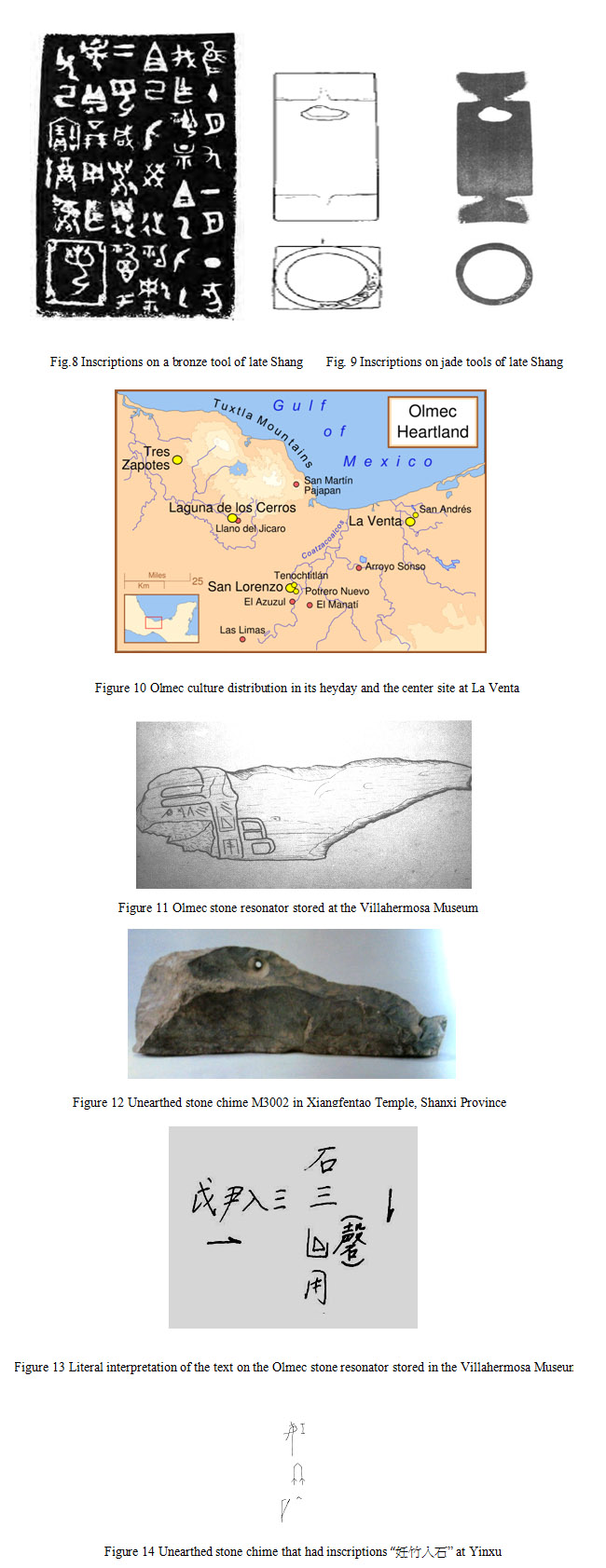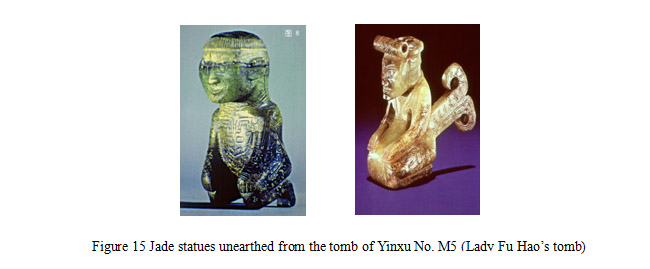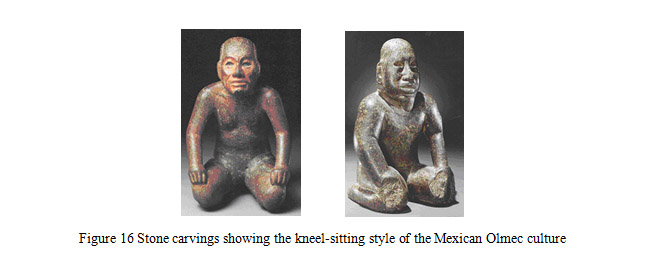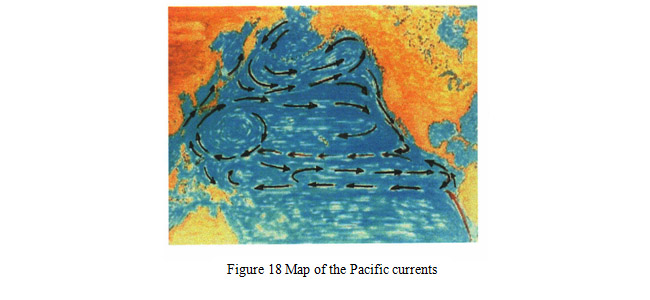Editor’s Note: We thank Professor Fan for giving us the permission of translating this paper into English and publish it on www.ChinaUSFriendship.com; this paper first appeared on the 9th volume of the Cultural Relics World in 2012.
3
The oracle-bone inscriptions were used by the royal family of the late Shang Dynasty to record activities of their daily divinations. In fact, they also engraved texts of important meanings on bronze (Figure 8), jade (Figure 9) and stone tools. La Venta was the center of the Olmec culture in its heyday; its geographical site was near the Gulf of Mexico on the east coast of Mexico (Figure 10). The Olmec culture was widely distributed in its heyday and the texts remained on the jade tablets in the La Venta ruins were consistent with the Chinese oracle-bone inscriptions. Therefore, in addition to the above-mentioned texts, should there also be other texts left in the La Venta ruins? With this question in mind, when I was investigating the large quantity of Olmec artifacts unearthed at La Venta and stored in the Villahermosa Museum, I even found a stone resonator (Figure 11) carved with oracle-bone inscriptions. Such stone resonators were used as a percussion instrument. Its shape was basically the same as a stone chime unearthed in China (Figure 12). On this stone resonator were two lines of engraved inscriptions with each having four characters arranged horizontally. After deciphering this ancient text structure, reading from left to right they were “戉尹入三” (Yue Yin Ru San). In the simplified form, the character "磬" (qing resonator) was written as “ㄩ” without sealing the box, as a possible symbol for its specification. It could be deciphered as “石三(此)磬用” (“stone three (this) resonator use,” character by character).” “尹” (yin) in the oracle-bone inscriptions meant the official in charge of the local government affairs. [30] “戉” (Yue) was the name of the place. So, “戉尹” meant the local official at Yue. “入” (“into”) has been explained earlier to have another meaning of “rendering tribute“ by the local government to the royal family of the central government. In Lady Fu Hao’s (Fu Hao妇好) tomb at Anyang excavated in 1976, a stone chime was unearthed with the engraved characters “妊竹入石” (“Ren Zhu ru shi”) on it. Another jade dagger-axe engraved with “卢方皆入戈五” (the Lu Fang 卢方tribe), Jie (jie皆is the name of the leader), ru (enter 入), ge (dagger-axe 戈), wu (five五)) was the information of the tangibles that the leader Jie of the Lu Fang tribe presented to the king of Shang (Figure 14), [31] which can be confirmed with the account of the oracle-bone inscriptions.

MMany records in oracle-bone inscriptions listed the content of the tribute that the officials of the local government rendered to the central dynasty, for example:
虎入百 (Hu虎 ru入bai百) meant the magistrate Hu of the ancient tribe/seigneur state rendering tribute (入) of hundred (百) slaves/tortoise shells to the central dynasty). (《He Ji》 9272 《合集》9272)
竹入十 (Zhu竹 ru入 shi十) meant the magistrate Zhu of the ancient tribe/seigneur state rendering tribute of ten (十) slaves/tortoise shells to the central dynasty). (《Yi 》4525 《乙》4525)
郑入二十 (Zhen郑 ru入 er shi二十) meant the magistrate Zhen of the ancient tribe/seigneur state rendering tribute of twenty (二十) slaves/tortoise shells to the central dynasty). (《Yi》5407《乙》5407)
A similar case was “Yue Yin ru san” (“戉尹入三”). Therefore, "Yue Yin ru san" was clearly speaking of the magistrate Yin at the Yue place rendering tribute of three (san三) stone resonators to the central authority of the La Venta regime. “石三(此)磬用” (“stone three (this) resonator use”) meant that among the three stone resonators, this one was accepted for use. At this point, we have reason to believe that the widely used writing in the Olmec culture was very possibly the commonly used oracle-bone inscriptions of the Yinxu, which would have been introduced to Mexico in the late Shang Dynasty. In connection with the Zhouyuan oracle-bone inscriptions discovered a few years ago in the Zhouyuan region of the Shanxi Province, there was amazing consistency between the text of the Zhouyuan oracle-bone inscriptions of the King Wen period and the Yinxu oracle-bone inscriptions. It is sufficient to show that in the late Shang Dynasty unified text was commonly used in considerable geographical ranges. [32] Not surprisingly, the Yin descendants were still using their hometown oracle-bone inscriptions after they fled to Mexico.
4
It is worth noting that the facial characteristics of the Olmec people not only looked similar to the Chinese people, but their living customs were also consistent with the Yin people of the late Shang Dynasty. For example, the posture of the Yin people was generally kneel sitting. That was the case for the jade statues among the unearthed jade artifacts (Figure 15). In the Olmec culture of Mexico, we also saw that there were a considerable number of human figures carved from stones in a kneel-sitting position (Figure 16).

The sitting posture is a basic custom of a nation’s everyday life. Different nations tend to have different sitting postures. Such a posture undoubtedly reflects the many customs of the Yin ancestors of late Shang Dynasty in the Olmec cultural legacy of Mexico.

Among the Olmec cultural relics of Mexico, there were still many human head sculptures with apparent facial features of black Africans. Almost all showed images of a warrior wearing a helmet (Figure 17). Consequently, most Western scholars who study the Mesoamerican cultures believe that the Olmec civilization was a civilization from Africa. [33] In fact, this is not appropriate. We saw the sudden rise and prosperity of the Olmec civilization, which was no accident. According to the previous discussion, we have no reason not to believe that this sudden rise and prosperity of the Olmec civilization was the contribution of the Yin people who fled to Mesoamerica after the Shang perished. None of these soldier heads that had African faces had a body. This was in stark contrast with the various kinds of statues of gods or children that had Chinese facial

characteristics. They could be African black people who originally came to Mexico from Africa, but were conquered by the Yin people. They might have competed with the Yin people, namely the main body of the Olmec civilization, who came from China; but they were killed by the Yin people and the descendants of the Yin people in the region where the Olmec civilization developed. Their heads could have been chopped off and used as symbols to pay homage to the ancestors of the Yin Dynasty. So it should be a reasonable explanation to link these human head sculptures placed in front of the tall statues of the gods and humans in the Olmec culture to the many decapitated bodies in the burial pits around the royal family tombs of the Shang kings in the region of Yinxu and the enduring custom of headhunting in Mesoamerica.
China and Mexico are thousands of miles apart and have tens of thousands of miles of Pacific Ocean waves separating them. How the Yin people crossed the waters to reach the New World has always been difficult to imagine. In fact, the Yin people had considerable sailing experience and ability. The poem “Chang Fa” (Long Hair《长发》; it said that the origin of the Shang people was a woman) in The Book of Songs∙ Ode to Shang (《诗经• 商颂》; a collection of ancient Chinese poetry) praised the ancestors of the Yin people. It said: "King Xiangshi (相土) of Shang made vigorous achievement, foreign vassals pledged allegiance to him;” indicating that as early as the time of their former father King Xiangshi the Yin people had crossed the ocean to conquer overseas. The poem "Yin Wu” (《殷武》) praised and worshipped the political and military achievements of King Cheng Tang of Shang (成汤 of Shang), in which it said: “Since King Cheng Tang established the Shang Dynasty, none of those distant nations of Di (氐) and Qiang (羌) dared not to render tribute and pay allegiance to the king. It recorded that the king of Shang was really the leader of many nations. It also had the verses: “They raided the territory ruled by Jing (荆) and Chu (楚), the descendant of King of Cheng Tang made meritorious achievements.“ Among the oracle-bone inscriptions there were numerous hieroglyphics used by the Yin people for describing vessels. The “Pan” word in the posthumous title of Pan Geng, famous for his relocation of the capital, was in the oracle-bone inscription the pictogram of boating for fun. After the fall of the Shang Dynasty, especially after the Duke of Zhou suppressed the Three Governors.

Rebellion, the son of Di Xin (King Zhou of Shang 帝辛) Wu Geng Lu Fu said (The Yizhoushu∙ Zuo Luo《逸周书•作雒》; Superfluous [Chapters of the] Book of Zhou∙ Zuo Luo ): “Prince Lu Fu (禄父) ran to the north, Guan Shu (管叔; the younger brother of King Wu of Zhou) committed suicide, Tsai Shu (蔡叔; another younger brother of King Wu of Zhou ) was put in prison; the Duke of Zhou conquered seventeen states of the Xong Ying (熊盈) ethnicity and nine cities occupied by the Fu Wei (俘维) people (of Huaiyi 淮夷 ethnicity).” In this chaotic situation, it was normal for the Yin royal family and aristocrats to flee by sea. As to how they reached Mexico, so far no sign has been found of overland travel to Mexico. A reasonable explanation is that they could only enter the Sea of Japan and later with the help of the Pacific currents be driven to Mesoamerica (Figure 18). It was said that experiments were conducted by people on rafts drifting from the Sea of Japan to Central America. As long as they carried enough rations and fresh water, they could rely on rainfall replenishment to reach Central America. Of course, whether the Yin people reached Mesoamerica by such a trip can still be further explored. But they did arrive in Mexico and contributed to the earliest civilizations of the Mesoamerica - the rise and prosperity of the Olmec civilization. There is credible evidence to say that they were the earliest Asian ancestors that discovered the New World before Columbus reached there. I wish many more academia colleagues would pay attention to this subject, and continue their in-depth research.
The article was written by the lamp at the Meditation Retreat of Longjiang,
Stone City, Nanjing on August 4, 2007
References:
1 Lee E. Huddleston, Origins of the American Indians: European Concepts, 1942-1929, University of Texas Press, Austin, 1967.
2 De Guignes, Researches sur les Navigations des Chinois du de l'Amerique, Et sur quelques peoples situes a l'extremite orientale de l' Asie, Rec. de l'Academie des Inscriptions Memorires, vol.28, 1762.
3 Edward P. Vining, An Inglorious Columbias, or, Evidence that Hwui Shan and the Party of Buddhist Monks from Afghanistan Discovered America in the Fifth Century, AD, D. Appleton, New York, 1885.
4 参看刘坤一:《欧美学者对古代中国人到美洲问题的研究》,《中国史研究动态》1981年,第1期。
5 Robert von Heine-Geldern, The Problem of Transpacific Influences in Mesoamerica, Handbook of Middle America Indians, vol. 4, ed. by R. Wauchop and others, University of Texas Press, Austin, 1966.
6 Michael D. Coe, San Lorenzo and the Olmec Civilization, Dumbarton Conference on the Olmecs, October 28-29, 1967.
7 Michael D. Coe, America's Fist Civilization, Princeton, New York,, 1988.
8 Carroll L. Riley and Others, Man across the Sea: Problem of Pre-Columbian Contacts, University of Texas, Austin, 1971.
9 白鸟库吉:《扶桑に就いて》,《地学杂志》19卷225期,明治四十年(1907)9月;桑原隲藏:《テイニングの〈无名のコロンブズ〉——亚细亚人の亚美利加发现说の绍介》, 《三宅博士古稀纪念论文集》。
10 参看王大有、宋宝忠:《图说美洲图腾》,人民美术出版社,1998年。
11陈志良:《中国人最先移殖美洲说》,《说文月刊》第一卷,第四期, 1940年。
12 朱谦之:《扶桑国考证》, 商务印书馆,1940年。
13 卫聚贤:《中国古代与美洲交通考》,说文社,香港,1970年;又《中国人发现美洲初考——文字与花纹》,石室出版社,台北,1975年。
14 张树柏:《古文明之谜》读者文摘远东有限公司,香港,1979年。
15 张虎生:《石锚物证于殷人东渡辨析》,《拉丁美洲丛刊》,1982年3期。
16 徐松石:《华人发现美洲考》,东南亚研究所丛书,香港,1983年。
17 罗荣渠:《扶桑国猜想与美洲的发现》,《历史研究》,1983年2期。
18 房仲甫:《殷人航渡美洲再探》, 《世界历史》1983年3期。
19 王大有、宋宝忠:《图说美洲图腾》,人民美术出版社,1998年。
20 H. Mike Xu, Origin of the Olmec Civilization, University of Central Oklahoma Press,1996.
21 参看日本学者贝冢茂树:《京都大学人文科学研究所藏甲骨文字•本文篇》 282、327、350、581、688诸片考释,京都大学人文科学研究所,京都,1960年;徐中舒主编: 《甲骨文字典》,10-13页,四川人民出版社,1988年。
22参看日本学者白川静:《殷の世系——いはゆゐ六示について》,《说林》5,1949年。
23 参看陈梦家:《殷墟卜辞综述》第十章,科学出版社,1956年。
24徐中舒主编:《甲骨文字典》578-579页,四川人民出版社,1988年。
25 参看日本学者白川静:《殷の王族と政治の形态》,《古代学》3-1,1954年;于省吾:26《从甲骨文看商代社会性质》,《东北人民大学人文科学学报》,1957年2、3合刊; 杨升南:《卜辞中所见诸侯对商王朝的臣属关系》,《甲骨文与殷商史》上海古籍出版社,1983年。
26 罗振玉:《增订殷虚书契考释》卷二、卷十二,东方学会, 1927年。
27金祖同:《殷契遗珠释文》第3叶,中法文化出版委员会,1939年。
28 Lorenzomn Ochoa, Marcia Castro-Leal, Guide Achéologique du Parc_Musee de Laventa, Gouvernement de l’Etat de Tabasco, Villahermosa, 1986.
29我曾以甲骨文月食记录推定商代灭亡的年代是公元前1027年,说见范毓周:《甲骨文月食纪事刻辞考辨》,《甲骨文与殷商史》第二辑,上海古籍出版社, 1986年,夏商周断代工程推定为公元前1041年,有误。我最近新推定其年代应为公元前1071年,说见范毓周、周言:《西周金文历谱与历史年代探论》,《史学月刊》2002年1期。
30范毓周:《甲骨文中的尹与工——殷商职官考异之一》,《史学月刊》1995年1期。
31 中国社会科学院考古研究所安阳发掘队:《安阳殷墟五号墓的发掘》,《考古学报》1977年第2期。
32 范毓周:《试论灭商以前的商周关系》,《史学月刊》1981年1期。又Fan Yuzhou (范毓周),Some Comments on Zhouyuan Oracle Bone Inscriptions: A Response to Edward L. Shaughnessy, Early China, Vol. 11-12, 1985-1987.
33 http://www.raceandhistory.com/historicalviews/ancientamerica.htm
|